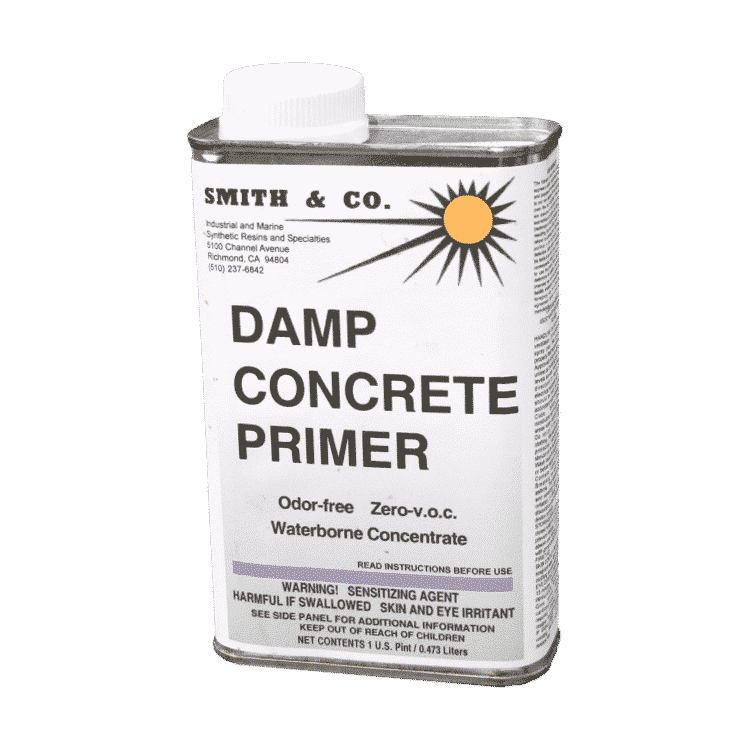Modern technology gives us a variety of durable floor paints, whether polyurethane or epoxy based, yet still the most important part of creating a durable finish is priming concrete properly. The primer is the substance that sticks to both your concrete and to your top coat,
Priming Concrete with Damp Concrete Primer (DCP)

Smiths Damp Concrete Primer is intended to be used as an adhesion-promoting primer for a wide variety of adhesives, sealants and coatings on dry or damp concrete. It will create chemical bonds between modern Polyurethane sealants and paints, as well as Epoxy resins and paints.
It is an odour free, zero VOC, waterborne concentrate that will glue any topcoat to wet or dry concrete.
When you want a paint or coating to stick to concrete and stay stuck, use Damp Concrete Primer first.
In order to use Damp Concrete Primer, add two parts by volume tap water to one part by volume of DCP. Mix well, and observe that the mixture becomes an opaque tan liquid. The mixture may be applied by the same kind of rollers or brushes as are used for latex paints.
The adhesion-promoting film is effective in a thickness of only a few thousandths of an inch (a hundred microns or less). This film is distributed over a surface by brush, spray or roller application of the emulsion onto the cement surface. Natural evaporation of the water will leave a thin film of the DCP resin itself directly wetting the cement surface. One pint (475ml) of concentrate is adequate for 200 square feet (approx 20 sq metres) of average concrete. On more porous concrete, more may soak in and the coverage may be less.
A quart (950ml) of DCP mixed with two quarts(1,900ml or 1.9l) of water is to be applied over four hundred square feet (approximately 40 square metres) or less as above. Use what you mix within an hour. Once applied to a concrete surface, allow to dry until the appearance changes from a tan liquid to a clear, dark amber oily film. Further drying until the film is slightly sticky is ideal. This typically takes one to three hours. Then apply any topcoat according to the manufacturer’s instructions. If you see the Damp Concrete Primer turning yellow as it dries, this indicates there was excessive water in that area of the concrete. If the concrete is really wet, instead of merely damp, this may happen. Immediately apply more DCP to disperse the yellow granular material. A normal appearance of properly primed concrete will be a transparent amber film.
How does It Work
Besides forming chemical bonds with properly prepared concrete, the Damp Concrete Primer will form chemical bonds with freshly applied isocyanate-cured polyurethane paints or polyurethane elastomeric coatings or amine-cured epoxy paints or epoxy coatings. Then they stick and stay stuck . It chemically bonds to any topcoat we know of , creating the strongest, most water-resistant chemical bond possible.
Proof of Priming Capabilities
Damp Concrete Primer was introduced in 1992 as a component of a kit for the repair of leaking bathroom floor drains in Sweden. This technology has since been certified by the Swedish agency that regulates such installations, and to date in excess of six thousand floor drains in Sweden have been repaired by our licensees, with no failures.
Damp Concrete Primer was introduced to the U. S. market in 1999, and they have had no failures in any application.
Priming Concrete that is Old, Porous, Dirty or Oil Contaminated
Concrete ages, and is exposed to contaminants through it’s life.
If your concrete is porous, dirty or contaminated it should first be sealed with Smiths permanent Concrete Sealer. Proceed as before to prime and then paint.
If your concrete is physically crumbly or extremely porous, it can still be made fit for coating by treating with Smiths CPES. This will give durability to the damaged concrete, seal porosity and provide direct adhesion for most modern top coats, such as Polyurethane and Epoxy finishes. Damp Concrete Primer is not required for concrete that has been sealed with CPES.


